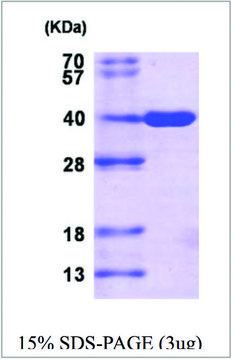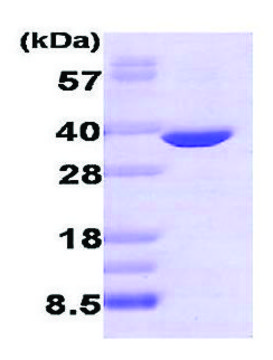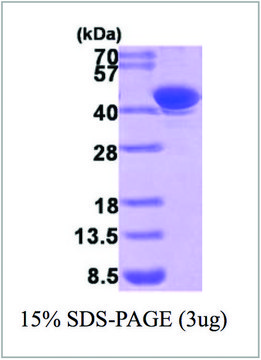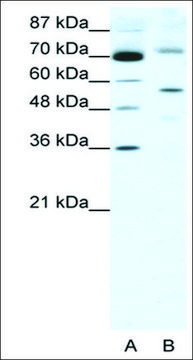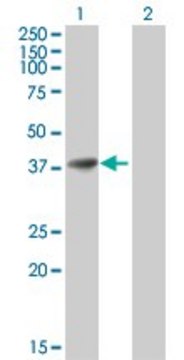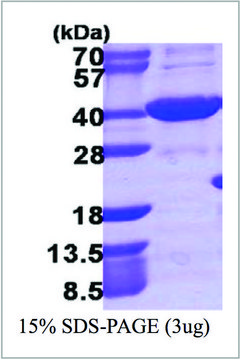SRP6087
AKR1C1 human
recombinant, expressed in E. coli, ≥90% (SDS-PAGE)
Sign Into View Organizational & Contract Pricing
All Photos(1)
Synonym(s):
20-alpha HSD, Aldo-keto reductase family 1 member C1, DD1/DD2, DDH1, HBAB
Recommended Products
biological source
human
recombinant
expressed in E. coli
Assay
≥90% (SDS-PAGE)
form
liquid
mol wt
38.9 kDa
packaging
pkg of 100 μg
NCBI accession no.
shipped in
dry ice
storage temp.
−70°C
Gene Information
human ... AKR1C1(1645)
General description
AKR1C1 (aldo-keto reductase 1C1) is one of the four isoforms (AKR1C1–AKR1C4) of the phase I drug-metabolizing enzyme family called AKR1C. This enzyme is thought to be composed of 323 amino acids, and its mRNA is expressed in brain, mammary gland tissues, liver, adrenal, prostate, uterus and testis.
Biochem/physiol Actions
AKR1C (aldo-keto reductase 1C) family of proteins is responsible for maintaining steroid homeostasis, activation of polycyclic aromatic hydrocarbons and the metabolism of prostaglandin. These enzymes function as NAD(P)(H)-dependent oxidoreductases and are responsible for the production of alcohol by catalyzing the reduction of aldehydes and ketones. Studies show that up-regulation of AKR1C1 is linked with resistance to anti-cancer therapeutics such as, adriamycin, daunorubicin and cisplatin. In human endometrial tissues, this protein is responsible for the conversion of progesterone to a biologically inactive metabolite. Studies in cultured endometrial stromal cells show that the mRNA expression level of AKR1C1 is inversely dependent on the level of progesterone, thus suggesting that progesterone controls its own local concentration through AKR1C1 enzyme in endometrial stromal cells at peri-implantation periods.
Physical form
0.5 mg/mL solution in 20 mM Tris-HCl buffer (pH 8.0) containing 1 mM DTT and 20% glycerol.
Preparation Note
Centrifuge the vial prior to opening.
Other Notes
MGSSHHHHHH SSGLVPRGSH MDSKYQCVKL NDGHFMPVLG FGTYAPAEVP KSKALEATKL AIEAGFRHID SAHLYNNEEQ VGLAIRSKIA DGSVKREDIF YTSKLWCNSH RPELVRPALE RSLKNLQLDY VDLYLIHFPV SVKPGEEVIP KDENGKILFD TVDLCATWEA VEKCKDAGLA KSIGVSNFNR RQLEMILNKP GLKYKPVCNQ VECHPYFNQR KLLDFCKSKD IVLVAYSALG SHREEPWVDP NSPVLLEDPV LCALAKKHKR TPALIALRYQ LQRGVVVLAK SYNEQRIRQN VQVFEFQLTS EEMKAIDGLN RNVRYLTLDI FAGPPNYPFS DEY
Signal Word
Warning
Hazard Statements
Precautionary Statements
Hazard Classifications
Eye Irrit. 2
WGK
WGK 3
Flash Point(F)
Not applicable
Flash Point(C)
Not applicable
Regulatory Information
新产品
Certificates of Analysis (COA)
Search for Certificates of Analysis (COA) by entering the products Lot/Batch Number. Lot and Batch Numbers can be found on a product’s label following the words ‘Lot’ or ‘Batch’.
Already Own This Product?
Find documentation for the products that you have recently purchased in the Document Library.
Characterization of a human 20alpha-hydroxysteroid dehydrogenase.
Zhang Y, et al.
Journal of Molecular Endocrinology, 25(2), 221-228 (2000)
Expression of 20alpha-hydroxysteroid dehydrogenase mRNA in human endometrium and decidua.
Nakajima T, et al.
Endocrine Journal, 50(1), 105-111 (2003)
Induction of neoplastic transformation by ectopic expression of human aldo-keto reductase 1C isoforms in NIH3T3 cells.
Chien CW, et al.
Carcinogenesis, 30(10), 1813-1820 (2009)
Human cytosolic hydroxysteroid dehydrogenases of the aldo-ketoreductase superfamily catalyze reduction of conjugated steroids: implications for phase I and phase II steroid hormone metabolism.
Jin Y, et al.
The Journal of Biological Chemistry, 284(15), 10013-10022 (2009)
Our team of scientists has experience in all areas of research including Life Science, Material Science, Chemical Synthesis, Chromatography, Analytical and many others.
Contact Technical Service